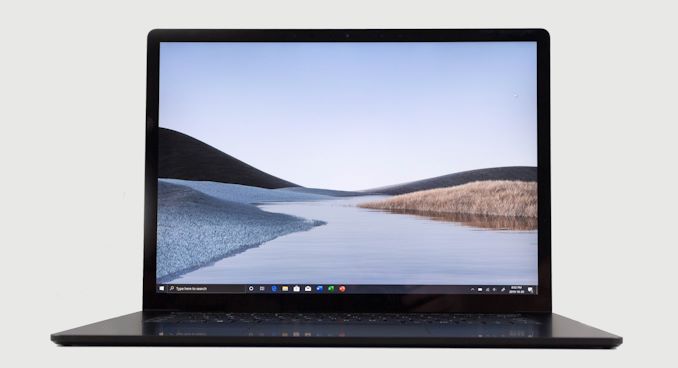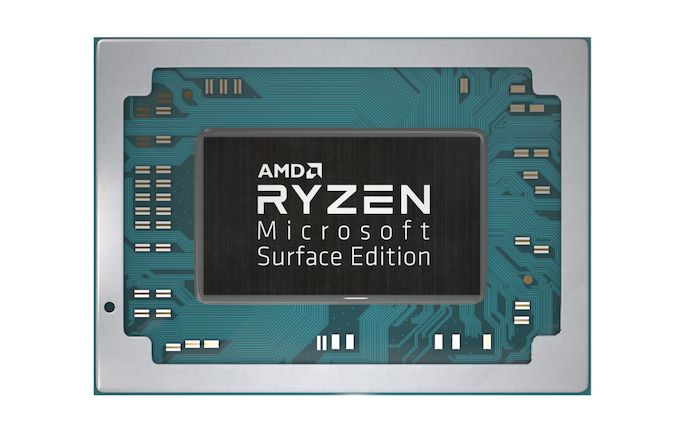The Microsoft Surface Laptop 3 Showdown: AMD's Ryzen Picasso vs. Intel's Ice Lake
by Brett Howse & Andrei Frumusanu on December 13, 2019 8:30 AM ESTFinal Words
Two laptops. Two platforms. It is rare to have a chance to see a manufacturer offer such equal footing to both AMD and Intel by outfitting a premium laptop with processors from both. It represents a rare opportunity to get to test the latest processors from AMD and Intel in a laptop in such an apples-to-apples fashion.
In the laptop space, design, cooling, and a manufacturers requirements can play a big part in how a particular chip performs, thanks to adjustable power level settings, surface temperature adjustments, and more. We have seen the lowest tier CPU outperform the highest tier CPU just by the virtue of a better cooling system, so to have processors from AMD and Intel, both of which launched in 2019, in the same chassis is a wonderful opportunity.
There aren’t too many ways to sugar coat the results of this showdown though. AMD’s Picasso platform, featuring its Zen+ cores and coupled with a Vega iGPU, has been a tremendous improvement for AMD. But Intel’s Ice Lake platform runs circles around it. Sunny Cove cores coupled with the larger Gen 11 graphics have proven to be too much to handle.
On the CPU side, no one should be too surprised by the results. We've already seen on the desktop that AMD’s Zen+ cores were competitive, but slightly slower than the previous Skylake platform; and the new Sunny Cove microarchitecture from Intel is a big step forward in terms of IPC for Intel. On purely CPU based tasks, Ice Lake really stretched its legs, and despite this being a 3.9 GHz chip, in single-threaded SPEC 2017, it managed to come very close to a 5.0 GHz Core i9-9900K with a massively higher TDP. Zen+ is outclassed here, and that showed in the benchmark results, and especially in the benchmark time. On our 8-thread SPEC 2017 run, the Ice Lake platform finished just a hair over two hours ahead of Picasso.
But things fare better for AMD on the GPU side of matters. Even though Intel has certainly closed the gap with Ice Lake's iGPU, AMD seems to continue to hold an advantage, especially on the 11 Compute Unit Ryzen Surface Edition processor found in the Surface Laptop 3. Intel has dedicated a lot more die area to the GPU and the results put them almost on equal footing with the Vega based GPU on Picasso. On the more complex GPU tasks, AMD tends to have a slight lead, and AMD’s low-level driver support also seems to benefit them on DirectX 12 based tasks. But, Ice Lake’s GPU is helped by the much quicker CPU it is coupled to, so depending on the specific test it can be even quicker.
Ice Lake does all of this with much better power efficiency as well. Overall battery life is quite a bit longer, and idle power draw is notably lower as well. Case in point: at minimum screen brightness, the Ice Lake system was pretty much only sipping power, drawing around 1.7 Watts, versus the 3.0 Watts for the AMD system.
It was fantastic to see AMD get a design win in a premium laptop this year, and the Surface Laptop 3 is going to turn a lot of heads over the next year. AMD has long needed a top-tier partner to really help its mobile efforts shine, and they now have that strong partner in Microsoft, with the two of them in a great place to make things even better for future designs. Overall AMD has made tremendous gains in their laptop chips with the Ryzen launch, but the company has been focusing more on the desktop and server space, especially with the Zen 2 launch earlier this year. For AMD, the move to Zen 2 in the laptop space can’t come soon enough, and will hopefully bring much closer power parity to Intel’s offerings as well.
Meanwhile for Intel, Ice Lake has been years in the making, and, after a long delay, it is finally here. After digging into the platform in-depth, it’s clear that Ice Lake is an incredibly strong offering from Intel. The CPU performance gains are significant, particularly because they were made in the face of a CPU frequency deficit. But the biggest gains were on the GPU side, where Intel’s Gen 11 GT2 in its full 64 Execution Unit configuration is likely the biggest single increase in GPU performance since they started integrating GPUs. It pulls very close to AMD’s Vega, closing the gap in performance to almost zero.
2019 has been a big year in the laptop space, with both Intel and AMD bringing new tools to the game. 2020 should be just as exciting, and if we’re lucky, we’ll get another chance to do this all over again.













174 Comments
View All Comments
Zoolook - Saturday, December 21, 2019 - link
LP memory uses half size channels compared to regular DDR among other things, if you haven't designed your controller for it, it won't work, and since LP memory has only been used in the mobile sector earlier there was no reason for AMD to design the controller with that in mind.Extra transistors that could be used better elsewhere.
RSAUser - Friday, December 13, 2019 - link
Remember this is Zen gen 1, when they still had the RAM frequency scaling issue vs infinity fabric.sorten - Friday, December 13, 2019 - link
Whoa, nice surprise for a Friday morning! Thanks for the review.Results are about what I expected, and I guess this was the risk for AMD pushing out their previous gen APU for a high profile product. I hope they get the Zen 2 APUs into products soon.
coder543 - Friday, December 13, 2019 - link
Microsoft really should have waited until mobile Zen 2.sing_electric - Friday, December 13, 2019 - link
Honestly, I have no earthly clue why MS makes most of the choices it does with its hardware products. They launched the Surface Studio with a Maxwell GPU right after Pascal came out... then waited 2 years until after Turing was out to update the machine with the Pascal GPUs they should have had at launch. For a machine that is theoretically for "creators" (though, let's be honest, is probably mostly found on the desk of the boss of whoever is actually doing the creating).They did the same thing with the ARM-based Surface Pro X with a custom chip based on the already-year-old Qualcomm 8cx. Honestly, the bigger surprise is that the updated Surface Pro series actually uses current-gen Intel chips soon after they launched.
tipoo - Thursday, December 19, 2019 - link
Bet the Studio 3 comes out right before Ampere too. I agree, sometimes it seems like they're deliberately making themselves a bit less appealing not to piss off their partners.TheinsanegamerN - Friday, December 13, 2019 - link
And miss all the holiday sales?Here is the issue: AMD's mantra is "wait until X", but when "X" arrives, it is outclassed by the competition, or comes out after the major holiday season. The rest of the world doesnt run on AMD's schedule, and this only hurts AMD. If MS didnt want to use zen+, the consumer model would have simply gone with ice lake.
Zen 2 APUs should have come out when the rest of zen 2 did.
Meteor2 - Friday, December 13, 2019 - link
For sure, but they don't have the money to do the development concurrently. Something had to give.lmcd - Friday, December 13, 2019 - link
More like they don't have the money to hold CPU releases for GPU integrationChiplet arch should fix this and let AMD integrate within the same cycle -- this should, in theory, be the last cycle or second-to-last cycle where AMD ships a previous-generation "APU."
RSAUser - Friday, December 13, 2019 - link
Don't think it was the money for mobile Zen 2, more likely lack of available wafers from TSMC, rather supply Desktop as enthusiast and gamers will then market the product while cashing in profits from Epyc.